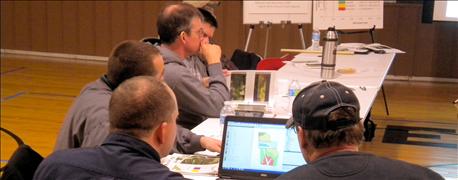
If you haven’t heard of Infield advantage, maybe you’ve heard of the On Farm Network. That name is still used for this voluntary field testing program in Iowa. It was known by that name in Indiana until the name was changed to give the program its own unique identity.
Meg Leader, Indiana State Department of Agriculture, heads up the program. Farmers voluntarily agree to be part of a local group, and enroll fields in the program. The primary goal is improving nitrogen efficiency, although an advanced level of the program can include other comparisons besides nitrogen use.

GATHER AND SHARE: Farmers who are part of an Infield Advantage group gather in Newport to discuss recent results. (Photo courtesy Meg Leader, ISDA)
Some farmers have been in the program for several years now. In 2014, Linda Prokopy, a Purdue University professor, surveyed farmers who participated to see what they were gaining from the program. The three questions and their responses shed light on why many farmers think it’s worth the time and effort to take part.
1. Opportunity to compare N management styles and change your N management
Prokopy asked farmers who took part if they had changed their N management techniques because of participating in the program. The answer varied depending upon how long the farmer had participated. Overall, nearly two in three said they had changed their N management. Percentages for those saying they had changed N management after three, four and five years in the program, respectively, were; 61%, 64% and 86%.
2. Chance to reassess and possibly change N application rates
Overall, nearly six in 10 said they had changed rates because they participated in the program. Again, it varied by years of participation, although there was no clear pattern. The percentage of those saying they had changed their N rate due to being in the program after three, four and five years, respectively, was 63%, 55% and 43%.
3. Gain information that could help you increase profitability.
Farmers in the survey were asked if they had increased their profitability after being in the program. Here’s where the rubber meets the road. Overall, 44% answered yes. The farmers who had been in the program the longest were the most positive that the program had helped them increase profitability. Percentages who said yes for those in the program three, four and five years, respectively, were: 44%, 41% and 47%.
About the Author(s)
You May Also Like




